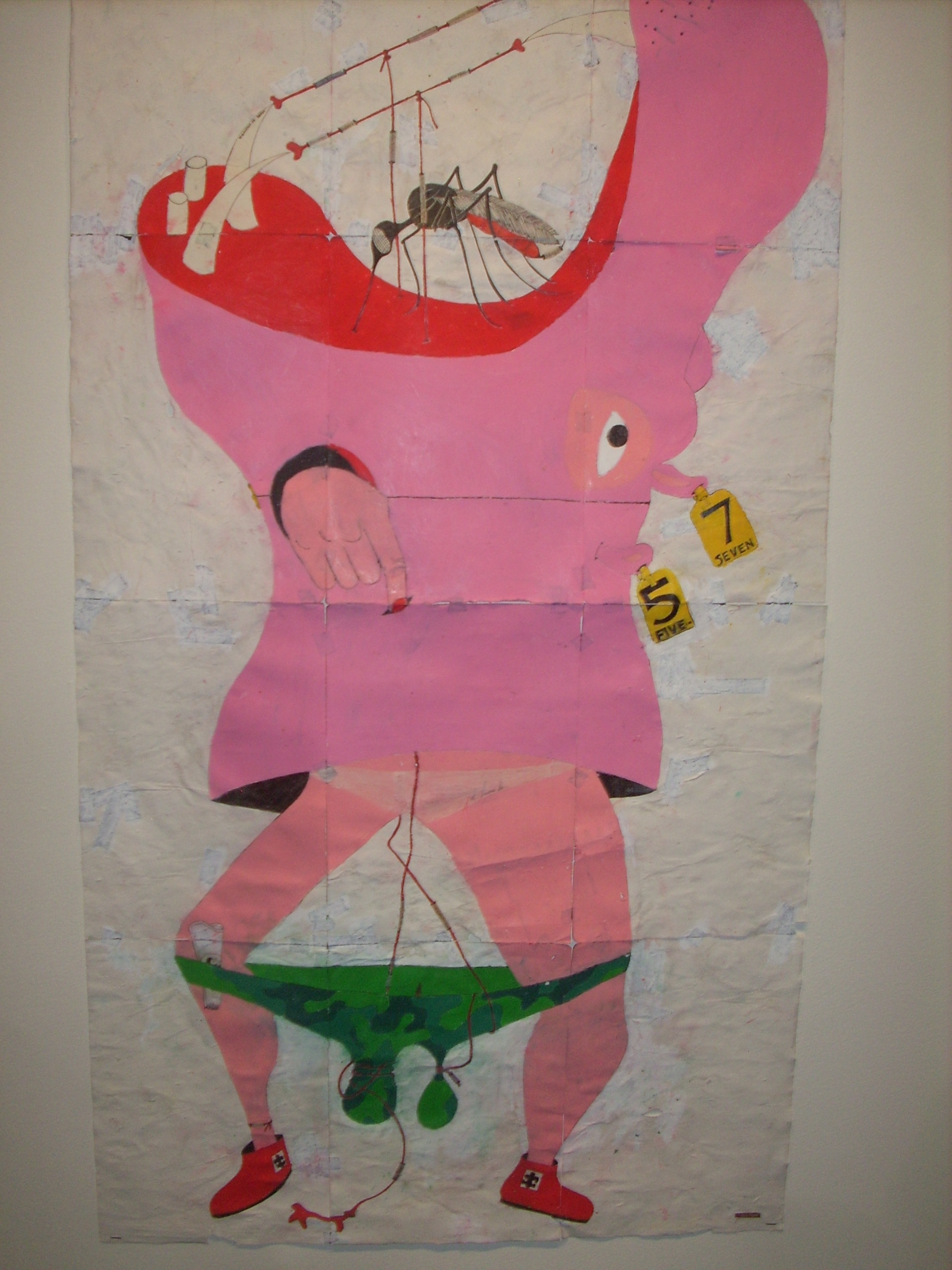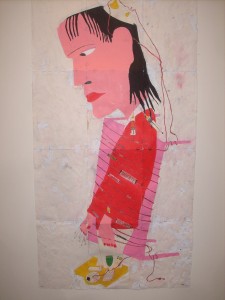The big news yesterday was The Getty’s roll-out of Pacific Standard Time: LA/LA. (And you thought they were going to just let go of that franchise – after (let’s face it) lackluster performance and architecture modules? Not a chance.) ‘LA/LA’ stands for L.A.’s Latin American nexus – which is extensive and complex enough to carry the franchise for quite a while. I sort of wondered about that around the time Pacific Standard Time debuted in 2011. I mean, as long as we were carrying the concept clear to San Diego, it was only a short hop across the border to the cradle of Pacific Standard Surrealism – not to mention a more or less continuous coastline all the way from Baja California to Tierra del Fuego. While the boys of summer were busy pushing girls off their surfboards – I mean, building the mid-century art scene here (do I sound bitter?) – what was going on in Mexico City, Bogota, and Santiago (to say nothing of Ecuador, Peru, Costa Rica, Guatemala, etc.)?
This time, the Getty isn’t stopping with the West Coast, though. The theme here is on all Latin American connections – including Brazil, Venezuela (hey Dude—big shout-out to El Sistema!), Argentina, even the Caribbean. Which makes me wonder if The Getty is thinking of branching out, say to Miami. So many of those Latin American nexae terminate in Miami.
It’s hard not to be aware of Mexico City – which is rapidly becoming a powerhouse in contemporary art. And if fairs do nothing else, they remind us tangibly of the artistic ferment in other South American capitals. (As Paris Photo did just last month, with presentations by galleries from Buenos Aires, Caracas, La Paz and Sao Paolo, as well as Mexico City.) Beyond L.A.’s specific connections with Latin America and the Southern Hemisphere, it was apparent to me, from one of the first Armory fair weeks I covered for this blog and Artillery, that there was a vast range of artistic production throughout all of Latin and South America of which I scarcely had an inkling (gleaned essentially from back-of-the-book reviews in ArtForum). Ironically, I think I first scratched the surface of this domain in a New York gallery’s fair booth at the actual Park Avenue Armory (the ADAA show uptown). The gallery was Mary-Anne Martin/Fine Art which has emphasized Mexican and Latin American art since its inception. Since that time (not to mention Zona Maco and a zillion other fairs), it’s become fairly clear to me that some of the most powerful contemporary work being produced today is coming from Latin and South America.
Some of the projected shows sound absolutely fascinating. But the one that really grabbed me at the press conference yesterday was the San Diego Museum of Art’s (wouldn’t you know it would be out of town?) Indigenismos (“Amerindian Inscriptions in the Art of the Americas”) – which, far beyond the obvious power of contemporary Latin American art, reaches deep into almost toxically troubled cultural roots (given Spanish, other European and corporate powers’ near-genocidal predations of these cultures). Will there ever be sufficient accounting of these crimes? MOCA’s proposal sounds pretty great, too – encompassing Japanese artists in c.1930s Brazil, the Grupo Signo in Chile, and late 1950s informalism in Argentina. The Chinese American Museum’s and Japanese American National Museum’s proposals sound fantastic, too. (It’s supposed to be “Pacific Standard Time,” after all.)
I may have more to say about PST: LA/LA. But this is a long way off (2017); and I’m getting away from the point of this post – which is really my own little wish list. (And since it’s a wish list, let me just say that I wish I spoke Spanish as well as our Mayor, the Honorable Eric Garcetti.)
First of all – speaking of things I may have more to say about (and hopefully soon), please don’t miss the Von Lintel Gallery’s inaugural exhibition of photography, Lay of the Land, curated by Farrah Karapetian. It’s up only through the end of this week and is a must-see – an almost perfectly curated show.
A couple of other must-see shows:
Roger Herman at ACME – an important, perspectival show for the artist, with a range of work that reaches back to 1992-94, and forward to the present, with both large scale (a large blue diptych that’s simply gorgeous) and smaller work, including actual books of gouache/oil works on paper that expose the ideas and gestural roots of some of the abstract motives in evidence in the larger work. The color palette is surprisingly varied and unrestrained – with an intensity, even lushness, that seems new to me.
Speaking of Latin American influences in L.A. – Camilo Restrepo’s current show at Steve Turner Contemporary – El sueño de la Razón Produce Monstruos is another complicated pleasure. (Gee, ‘tell me about it,’ I think, as I look at the title again.) I fell in love with Camilo Restrepo’s work when I saw his first show at the gallery (This is a wound, not just the drawing of a hole). Restrepo, who’s originally from Medellín, once the cocaine capital of Colombia, clearly puts some deliberation in the title, his statement of the thematic material of his drawings and paintings – it’s a part of the work, the flag he flies. You feel the pain with the pleasure. The work is scabrously, scarrifyingly political; fully encompassing the cultural political domain – the culture of objectification; of pacification and paranoia; social complacency and consumer distraction.
On one level, it’s an art of caricature; except that he’s not necessarily caricaturing a specific individual or situation. His ‘solo’ caricatures, rendered in flat, wax pastels – pink or (Caucasian) flesh-colored, with lipsticked mouths and sharply etched features – can be sewn up into larger, diagrammatic and quasi-narrative ‘landscapes’ (in this particular show, they’re titled “Land Reform”); but they’re more of a MAD Magazine cartographic species. The comically flattened, distorted figures, with attenuated limbs, extensions and accessories are wrapped up and over-gadgeted in vasculature, circuitry, intubations. (Points of comparison abound – from Grosz, El Lissitzsky, Miro, Guston, Dunham to political cartoonists and children’s book illustrators – but Restrepo’s style is uniquely his own.) He gets (and demonstrates) how interconnected the social, political, cultural and psychological aspects of any society are. The ties that connect are the ties that bind, cut, and strangle; and finally eat us alive. There’s cruelty and hilarity from any perspective and especially head-on.
The press release identified some of these figures as caricatured loosely on some of the Colombian narco-traffickers of Restrepo’s hometown, but it’s fairly clear both from the iconographic details and the titles that they have a much broader cultural sweep (e.g., a ‘beisbolista’-luchador in pink stripes proclaiming himself tu padre cabron (asshole? Well why not?), bearing insignia from at least three U.S. baseball teams, including the New York Yanquis, the Detroit Tigers, and the Cleveland Indians, carrying what could be the world or a bomb on his shoulder and what looks like a balloon of embryonic creatures on his hooked prosthesis. Restrepo takes a fairly broad world view, but he’s not about to ignore the the vitiating influences of U.S. \commercial culture or its facilitation of international murder and mayhem. I don’t mean to go on like this, but you get the drift. Just go have a look and ask to see whatever else might be on hand from his first show.
Now that I’m heated up, I should also remind you to have a look at a group show at the always charming Chinese American Museum downtown (in L.A.’s original pueblo center across Alameda from Union Station), taking its inspiration from the freshly controversial Sriracha and other hot salsas and condiments – Mexican, Chinese and others. The show is L.A. HEAT (Taste Changing Condiments), and, without offering a critique, I can promise that at least a few of its 29 participating artists are bound to tantalize your palate.
Television is culturally front and center in recent years – we’re clearly in a golden age (ironic, since I never see enough of it); but movies, especially American movies, for all their crashing spectacle, are increasingly forgettable, almost dismissable at first viewing. Cinema Vezzoli, contrary to Christopher Knight’s recent blandishments in the Los Angeles Times, will not offer “a welcome respite” from this sad reality. What is indeed a “baroque spectacle” (Vezzoli’s own description) is not given further dimension or otherwise elucidated or illuminated by these occasionally lush but puerile fantasies and embroideries. Knight’s attempt to bolster his critique with art historical contextualization (simplistic if not actually misread) is sheer sophistry. A slipshod art history tutorial is no substitute for an actual critique. I’d rather hear him elaborate a bit on how the “cheerfully nauseating” offers relief from “humdrum tragedy [of modern life].” My own advice is to skip Vezzoli altogether and turn to an artist (and movie director) truly capable of illuminating this ‘spectacle’ – John Waters.
Finally, a suggestion. It’s actually cool today; and you could hypothetically go outside and convey yourself to a gallery if so inspired. Inspiration has a way of wilting in the heat, though – and it was particularly extreme last week. How difficult would it be to push gallery hours later in the evening – when it’s not such a torture to actually get there and stand in the (not always air-conditioned) gallery. I can see that there might be an issue with the lighting. My suggestion is that galleries experiment with low lighting – or even candlelight. (Might be charming.) As the climate changes, it’s only going to get worse, so we might as well start experimenting with possibilities now. The future is looking darker for many reasons, among them the simple fact that we’re going to have to keep blinds and curtains drawn and lights low most hours of day and night in order to stay cool.
And speaking of the conveyors of cool: it would be great if some (if not all) of us could team up into carpools or shuttles to make our sometimes far-reaching art and culture itineraries a bit more manageable. Lighter on the carbon imprint, too.




